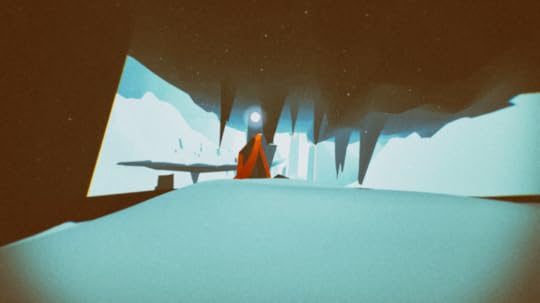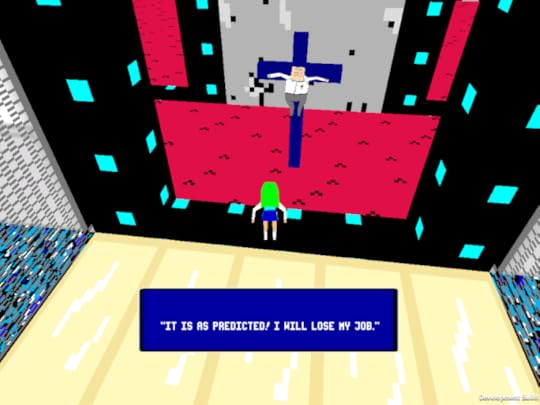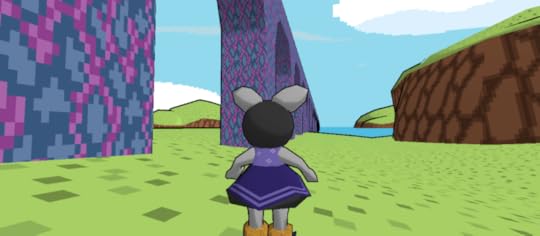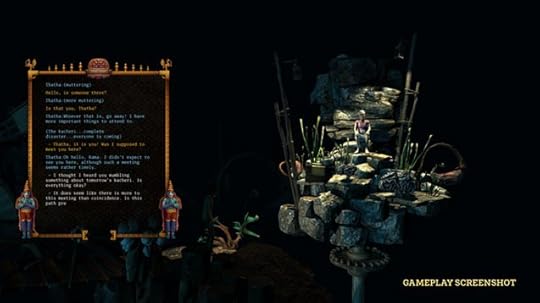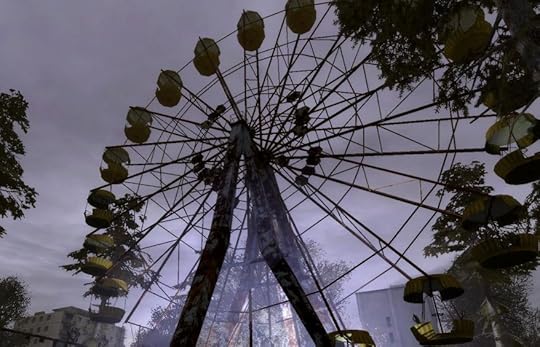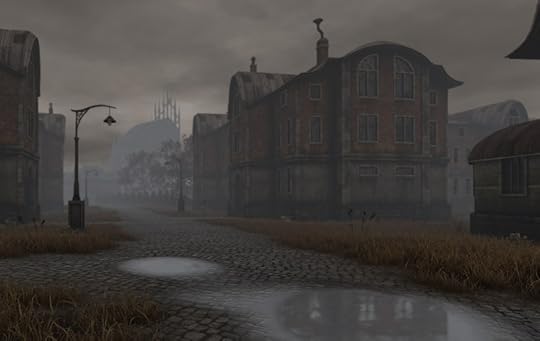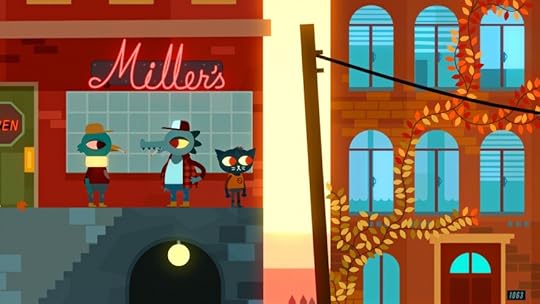Kill Screen Magazine's Blog, page 100
June 25, 2016
Weekend Reading: Man, What a World
While we at Kill Screen love to bring you our own crop of game critique and perspective, there are many articles on games, technology, and art around the web that are worth reading and sharing. So that is why this weekly reading list exists, bringing light to some of the articles that have captured our attention, and should also capture yours.
///
Gender and mutilation in myth and horror goes deep, but there’s something more grounded and eerie about how it is captivated in the work of Julia Gfrorer, one of the alternate comic world’s best masters of fear. Claire Napier writes about the succinct way that Gfrorer’s men are doomed.
What Happened to Kate Lanphear’s Maxim, Theodore Ross, Jezebel
At the end of 2014, fashionable icon Kate Lanphear was tasked with a dramatic rebranding of Maxim, once the dominating men’s lifestyle magazine that was bleeding readership. Many saw her direction as a feminist and modern vision for the frat boy’s periodical, but as noted by Theodore Ross, who worked there as the transformation occurred, these priorities may have been more projected upon Lanphear than truly being her prerogatives. With Lanphear’s short tenure over the publication over, Ross examines how Maxim changed publishing, and may have damned everyone in the process.
Maxim, March 2015
The Playboy Interview with Ta-Nehisi Coates, Bomani Jones, Playboy
Speaking of rebranded men’s lifestyle magazines, Playboy’s Bomani Jones sat down with Ta-Nehisi Coates, one of the most prominent voices in America. Discussing his book, Between the World and Me (2015), his groundbreaking “The Case for Reparations” story from The Atlantic and, yes, Marvel’s Black Panther, this chat with Coates is necessary reading.
The post Weekend Reading: Man, What a World appeared first on Kill Screen.
June 24, 2016
Fulcrum aims to capture the grace and freedom of snowboarding
When FRACT OSC (2014) creator Phosfiend Systems’s Richard Flanagan met up with Ben Swinden at the 2015 Toronto Game Jam, they found serendipitous inspiration in their shared love of snowboarding. The two quickly came up with the idea of an infinite, looping mountainscape, full of “branching pathways, hidden areas, and other secrets”—a low-poly love letter to their favorite sport. The prototype that resulted from the jam was rough, and difficult for many players, but they knew they’d hit on something meaningful. For now, they call it Fulcrum.
“Snowboarding has been a big piece of both mine and Richard’s lives. It’s a very special thing,” says Swinden. “For me, [it’s] all about the motion. Moving down the mountain in perfectly smooth, beautiful arcing movements. Improvising with small adjustments and short hops to navigate the terrain. It was a feeling I’ve never gotten a sense of while playing traditional snowboard games, which usually focus on big jumps and how many times you can flip. We’re trying to put the focus on the basics, making the movement feel as good as possible and then building from there.”
As for Flanagan, he tells me snowboarding’s “perhaps the closest thing to a spirituality” he has. “I love riding in the woods, either off-piste or backcountry. Every decision can concatenate into either glorious or unfortunate discoveries. Swerving through trees, punching through branches in the hopes of discovering an opening on the other side—riding powder that maybe no one else ever has is completely transportive. When I’m getting lost in the woods, pushing my mind and reflexes, everything else just melts away and I’m left with these perfect moments between bails and pauses, and it’s beautiful.”
“a connection with re-consolidating broken, repeating memories”
From what we’ve seen so far, Fulcrum promises to deliver an approximation of this experience, though it goes deeper than being merely a snowboarding simulator: It has a narrative, for one, even if the developers at Phosfiend are reluctant to say too much about it at this early stage. And its Tron-inspired environments are self-consciously that of a computer world; their low polygon counts and jagged edges, Flanagan says, serve to lend “an honesty to the medium.”
There’s also a metaphorical, or even introspective, function to the concept. “The repetitive, looping nature of the environments has a connection with re-consolidating broken, repeating memories,” says Swinden. “With time and context, stories and experiences can change.”
Precisely how the endless slopes will behave is still a matter of debate at this point. Swinden says they’re “looking at designing finite levels that encourage exploration as much as possible.” Once a player finds herself trapped within one looping stretch of terrain, she’ll have to collect floating orbs in order to unlock the next phase of the environment. By using a mix of bold contrasts and color coding, the team hopes to establish a straightforward visual language for these sequences.
Phosfiend has already shown off the project at several games-related events in Montreal at various stages of development, and they’ve been pleased with the response. “We’ve been especially happy with how people from drastically different experience levels can pick up the controller and figure out what’s going on,” says Swinden. “It’s really important to us to have something that can be enjoyed by as many people as possible. That being said, there’s still a huge skill component, and it will be really rewarding for those who want to master it.”
Fulcrum’s still “very early” in development, so we’ll have to wait a while longer to hit the slopes, but we can enjoy plenty of gorgeous screenshots in the meantime.
The post Fulcrum aims to capture the grace and freedom of snowboarding appeared first on Kill Screen.
Get lost in the bizarre wonder of Lilith’s collection of unfinished games
Games are mostly devoid of a “making of” genre. Indie Game: The Movie (2012) and various art books may tell the story of a game’s creation, but there is no Hearts of Darkness for games, largely because the amount of work and the number of art assets that go into a game means the “making of” commentary can’t really be strapped together out of film from the cutting room floor, or interviews from the set, or old storyboards.
What can give us a look into how games come together are what Lily Zone calls “pieces of game”—in the case of her Ephemera Pak, which is stuffed with prototypes in various states of completion. The Ephemera Pak is 21 fragments of games Zone has put aside, or recycled, or abandoned completely. They’re clearly unfinished, but aggressively so—the doors in City Maze have a sound effect: they say out loud, “This is the sound of a door opening.”
the ambiguity is what makes it exciting to explore
It turns out that this collection ends up being a good way to absorb some of Zone’s work—sifting through the files and finding out how far each of them goes has the same exploratory tone as Oneric Gardens (2014) or Crypt Worlds (2013), except instead of going from cavern to cavern, you’re going from app to app. It’s fractured and difficult to understand exactly what’s going on, but the ambiguity is what makes it exciting to explore.
The readme.txt file for Alien! Alien! Colonize the Heart lists some buttons and ends with “that’s all i can think of for now!” If you play that one and then boot up Pyramid Storm, you’ll see the same red spaceship and the same cute cyclops aliens. The palm trees in those games are the same as the ones from Oneric Gardens. Installing RPG through the setup file will give you dialog boxes full of question marks, just like trying to talk to anyone in City Maze will give you untranslatable glyphs.
Zone’s games very frequently carve out a particular sense of space and are populated with tiny encounters with an odd cast of characters, and in The Ephemera Pak, that is expanded to your filesystem. There’s no cohesive whole here—there’s not supposed to be—but there are components that when fitted together make up more than the sum of their parts.
You can find The Ephemera Pak on itch.io.
The post Get lost in the bizarre wonder of Lilith’s collection of unfinished games appeared first on Kill Screen.
Honey Rose puts another kick-ass woman into videogames
Honey Rose: Underdog Fighter Extraordinaire is what happens when you combine a traditional animation style and with genre-bending game challenges inspired by wrestling/lucha libre. Developed by Pierre Sylvain, Honey Rose: UFE is a life management simulation, presented as a visual novel with beat’em up segments. The protagonist is a student trying to balance studies with becoming a wrestling champion. Most of the game takes place in the visual novel/life management format and is driven by choices over balancing activities, and responses to situations. The beat’em up segments, split between tournament matches and street brawls, are less about combos or timing, and more about proper stat management and showmanship.
the spirit of the game extends beyond it’s mechanics
However, the spirit of the game extends beyond its specific actions. The idea for the wrestling protagonist came about in 2013 when Sylvain did an illustration series called “Fictional videogame heroines ABC” which highlights the need for more diverse videogame protagonists. The desire for greater diversity shines through not only with the game’s protagonist Honey Rose, but also in the conceptualization of the other characters in the game—most of whom are women and/or people of color.
As much as representation is something the game takes seriously, there aren’t modes for you to customize the main character, as Sylvain clarifies to Siliconera“…though you have control over her stats, and sometimes dialogue, she is her own character. There is no physical customization, and most of the time she’ll even decide what to say on her own. By making series of choices, you can affect how she ultimately reacts to some situations, but you won’t be able to straight out choose things out of line with what you/she did up to now.” This highlights how the player is not so much playing as Honey Rose, but rather acting as an advisor of sorts.
The struggle of managing demands from friends and family and achieving your own goals is central in this game. Regardless of the details, all of us are familiar with trying to balance different aspects of our lives, especially in early adulthood. This is a time where we are often both unsure of ourselves, as well as ambitious and hopeful for our futures. Honey Rose: Underdog Fighter Extraordinaire gives you the ability to guide a character through that process, and hopefully, kick some ass in the process.
Honey Rose: UFE is currently on Steam Greenlight. Be sure to keep up to date with Pehesse’s work and the game’s progress on Tumblr and Twitter
The post Honey Rose puts another kick-ass woman into videogames appeared first on Kill Screen.
An enormous and beautiful Indian transmedia project comes to videogames
In 2013, the Sri Lankan newspaper The Sunday Times interviewed Avinash Kumar, an experimental VJ (video jockey) from India, about a project he was heading: a short story that became a graphic novel that became an album with his audio-visual collective BLOT!, which then became something else altogether. The story was said to center on a South Indian man with synesthesia who went to Mars. “It’s become so much larger,” Kumar told the newspaper then, as a result of his initial concept of “Future Botanical” running away with itself.
Fast-forward to 2016. On June 14, a game called Antariksha Sanchar (Transmissions in Space) appeared on Steam Greenlight, describing itself as an “Indian point-and-click cultural adventure game.” Its inspirations are cited as mathematician Srinivasa Ramanujan and classical dancer Jayalakshmi Eshwar. The first teasers are of something dark and atmospheric but not haunting; slow-clicking instruments and cartoonish characters gently bobbing their heads give the distinct impression that this is a game about curiosity, about looking for something.
Of course, as you have probably guessed, Antariksha Sanchar is the product of Kumar’s experimentation, the first widely available example of the story that has been blossoming for the past three years. It has grown from quick and intense sketches on his Instagram into a pursuit supported by Indian developer Quicksand GamesLab, which pursues exploratory play-related research within Quicksand’s interdisciplinary consultancy. The demo was launched and praised at Sheffield Doc/Fest 2016, and seems set on getting Greenlit. If it delivers on its promises, it will not only be a welcome addition to the point-and-click genre, but also a rare example of a game set in South India.
Making a good game is a remarkable goal, and Kumar is well on his way there, but take a closer look and it becomes only a fraction of what he has in store. The game seems to be subtitled “Episode Zero” for good reason. Antariksha Sanchar, the website says, “is the first episode of our transmedia cultural experiment—amplifying India’s timeless philosophies and vibrant mythologies.”
“the first episode of our transmedia cultural experiment”
In an interview with Brown Paper Bag, Kumar calls the game’s website an “almanac.” It links to 3D models inspired by his research in South India because he aims to build a virtual museum. A Soundcloud playlist samples dancer Jayalakshmi Eshwar’s repertoire right alongside contemporary electronic musicians, and is described as a “repository.” Take a look at the Instagram that he uses as a design log and you’ll find more evidence of transmedia work: a shirt that he jokingly referenced in the article from 2013, mash-ups with pulp science fiction magazines, and a wind-up drummer with unclear connection to the story’s mathematician protagonist, a remnant of his early job as a toy designer for UNIDO. He was profiled by Mid-Day due to his use of gaming to interrogate Indian culture, by scroll.in for his recent success at Sheffield Doc/Fest, and by form, the legendary German design magazine, because his “audio-visual gift” and his commitment to creating a “serious” game. And in the middle of all of this, somehow, he settled on a September release.
Early experiments via Instagram
Antariksha Sanchar isn’t just India’s first major videogame. It isn’t just a cultural adventure, or a magical-realist experiment, or the result of three years of hard work on Kumar’s part. It isn’t just a tribute to his mother—whose dance production alongside Jayalakshmi Eshwar inspired the project—or to his country, which has been so long ignored by contemporary videogames. It’s a colossal effort that has grown like the extraterrestrial flowers that inspired it, medium after medium after medium coming together to tell the story of India’s most famous mathematician looking up at the stars.
It will be out in September, or maybe it won’t: it was earlier slated for a release in June, and the development time is long enough that a few months here or there seem insignificant. This project wants to take us to Mars. That’s worth waiting for.
Vote for Antariksha Sanchar on Steam Greenlight . Please?
The post An enormous and beautiful Indian transmedia project comes to videogames appeared first on Kill Screen.
The art of the set designer: How TV’s best shows come to life
You may never have heard of Diane Lederman, but that’s only because her work is, by design, invisible. As a production designer, she is responsible for making the worlds we see on TV and film look believable. She recreated mid-80s Americana for for AMC’s Cold War thriller The Americans (2013), and on HBO’s The Leftovers (2014) she envisioned an apocalypse at once heartbreaking, mundane and chillingly surreal. (Ugh, the plaster casts at the end of season one.)
This last vision struck an oddly resonant chord with one of last year’s best games, The Chinese Room’s Everybody’s Gone to the Rapture (2015), which similarly aimed to explore the emotional aftermath of the apocalypse. Lederman joined us in New York for Kill Screen Fest to speak with that game’s environmental artist, Alex Grahame about the similarities between their fields. Afterward, I grabbed Lederman to chat about her creative process.
KS: You mentioned onstage that you had eight weeks to create an entire world. How do you get started with a new project?
It always starts with research. Even if you’re creating someone’s home you might off the cuff think oh, I know what a contemporary apartment in 2016 looks like, do we really? Because there’s such a variety of furniture and things that are out there so it’s like if I really want to channel a couple who are in their forties and making $150,000 to $200,000 a year and they have two kids, the truth of the matter is I don’t know what that’s like. I really don’t, because I’m a single girl living in Manhattan. It’s not only pulling images of furniture or apartments or decor, it’s really getting in there and reading about where their lives might be and what their inspirations would be and what would turn them on, what they might collect or what might interest them or excite them, and try to include that in their world and in their environment.
KS: In some ways it’s very similar to reporting, going online, finding stuff. Do you end up talking to people?
All the time. When I worked on Wall Street 2 (2010), I spent—for that one we had money and time, I had 12 weeks of prep on that job—I spent a good portion of it meeting with and talking with Wall Streeters. I have no interest in Wall Street at all, they were the enemy, but it’s kinda fun to be in those situations that you would never otherwise be attracted to, you have to find out about, you have to in some way sympathize with, and I got to know these guys.
KS: When you’re out in the world is it hard to stop looking at things as research?
This room is kinda sad but upstairs, even, just the environment, watching the people, because environments are created by people, so like watching them and watching what they do, who they are and what turns them on, helps me understand their particular line of thinking.

via Diane Lederman
KS: In some ways your work strives toward invisibility, to be unnoticed. Is there something in your own work you’re really proud of that no one else might notice?
On The Leftovers there was a scene where we really recreated an entire street and I’m trying to remember when and where it was. The kid, Chris, he goes to a mailbox to pick up a drop for money, and so there was this entire street that we decorated, and I don’t know if people picked up on it, but we had an entire billboard about lawyers, and how to get cash for severance of your departed, and there was an entire fence that we covered with stuffed animals and a cross and ribbons. It was three days of work, we did all the storefronts, even the houses themselves, we’d go in there and we’d strip them down and recreate them from the bottom up.
KS: So are you stripping it mostly for your purposes or are there other concerns?
Anytime you create a movie or tv show, not just for production design, if everything that is in front of the screen isn’t intentional, then you’re making a mistake. That is first and foremost. Also when you work on locations I don’t want to use any of the homeowner’s stuff unless they’re okay with it, because it’s going to get damaged or lost or hurt or mixed up with our stuff in some way, so it’s safer for everyone if we just go in and take all of their stuff out.
If everything in front of the screen isn’t intentional, you’re making a mistake
KS: What are you working on now?
It’s called 13 Reasons Why, based on a young adult bestseller by a gentleman called J. Asher, and it’s about teenage suicide and cyberbullying and social media, and the opening story this woman kills herself and leaves behind thirteen casette tapes, and these tapes make the rounds to different people who in some way had a hand in why she did what she did, and so each episode is a different tape. We want very much for this to not be placed anywhere specific, because we want everyone to be able to identify with it, we’re not even naming our town.
The coffeeshop in the town is this main set that kids return to over and over, it’s called Monet’s, so I wanted it to not feel too hipster, not feel too contemporary, not feel too dated or too provincial, so every set is kinda like that. You have to find a medium ground and still have a sense of style that will excite people and be evocative in some way shape or form, and that is something I’m excited about. What we decided to do was rent an empty storefront and create our own. We (also) just took a storefront and I’m turning it into a vintage movie theater. So what the hope is is that no one will realize we’ve created these and just accept them, and in a way that answers your question, because this theater will look as real as it possibly can, and people will accept that it existed, but the reality is it’s this completely derelict building that I’m turning into a movie theater.
This interview has been edited for length and clarity.
Header via Vox
The post The art of the set designer: How TV’s best shows come to life appeared first on Kill Screen.
The Temple of No is interactive fiction for people who might not typically enjoy it
Crows Crows Crows, the studio created by William Pugh (co-developer on 2013’s The Stanley Parable), has launched their second game—a Twine adventure called The Temple of No.
The game is relatively short and comedic, similar in that regard to the studio’s previous short, narrative title, Dr. Langeskov, the Tiger, and the Terribly Cursed Emerald: A Whirlwind Heist (a name you are sure to have to Google to remember.) Made in the Twine engine, it’s a simple interactive narrative experience where you go on an adventure as either a woman, a “bloke,” or a frog.
“Have you ever played a good game made in Twine?”
The Temple of No is loaded with references, both to Geox Shoes (the Shoes That Breathe, evidently) and British comedian Spike Milligan, to name a couple. It is also rather referential to other Twine games and the medium in general. Alongside the assertion that no one has made a game of Snake (1998) in Twine—which seems unlikely since James Shasha made a version of Flappy Bird (2013) in Twine—you have references to perhaps the most well-known Twine title: Depression Quest (2013).
“Have you ever played a good game made in Twine? Like, one that’s actually good—not just ‘good for a twine game’?” The Temple of No asks. Whether or not Crows Crows Crows views Twine with anything approaching fondness is up for debate, though it certainly feels like a “no.” Either that, or they’re riffing on the apprehension many people into videogames have towards Twine and, to a greater extent, interactive fiction in general. That’s up for you to ponder.
In the meantime, you can play through this humorous little tale and enjoy what is becoming the studio’s signature, well-written humor. Dominik Johan does a bang-up job of matching that silliness with quaint, squiggly illustrations too.
You can play The Temple of No on the Crows Crows Crows itch.io page.
The post The Temple of No is interactive fiction for people who might not typically enjoy it appeared first on Kill Screen.
Stop calling Eastern European videogames pessimistic
It’s been 30 years since the Chernobyl disaster. There’s no denying that the explosion joined the gallery of horrors that haunt our collective imagination. As such, just like the images of concentration camps or the Hiroshima and Nagasaki bombings, it has been fueling the anxiety on which popular culture, including videogames, thrives. Even to most Eastern Europeans Chernobyl is a post-apocalyptic fantasy. It’s why accounts of the Chernobyl disaster and its effects, even from those closest to it, usually employ conventional narrative schemas. Typically, these are borrowed from the media and globally-consumed popular fiction, and so before worrying too much about the real place, our first concern when looking back at the disaster should be to identify these schemas, as it is these that inform popular thought on the historic event.
S.T.A.L.K.E.R (2007-2009). is a series of three games set in a fictional interpretation of the Chernobyl Exclusion Zone and developed in Ukraine by GSC Game World. Mark my wording: “developed in Ukraine” is not synonymous with “Ukrainian.” The latter adjective implies the embedding of the games in Ukrainian culture. This implication has led some to overemphasize the alleged cultural aspect of these games based on the mere fact of them being made and set in Ukraine. However, by talking about cultures we know little about, we may easily fall into treating them as too alien to be known, and thus, under the guise of accepting cultural differences, just reinforce myths and stereotypes.
This is why it’s important to establish what culture S.T.A.L.K.E.R. is really embedded in. The answer is simple: it is embedded in globalized popular culture, usually associated with the USA. Again, I’m avoiding this risky expression “American culture” for a reason. All the genres and conventions videogames use may have been popularized in the USA but they have become common property. You don’t have to be American to reproduce or parody them. Not to mention the fact that many of the luminaries of, for instance, American cinema were from outside the US, including Charlie Chaplin, Alfred Hitchcock, Fritz Lang, and Sergio Leone. This might be fairly obvious as nobody would make the mistake of treating US culture as an isolated block. And yet, the farther East we move, the more likely it is that people apply that kind of mistaken generalization.
There is nothing distinctly American, Ukrainian, or Eastern European about mutants, secret experiments, and zombies. Of course, the S.T.A.L.K.E.R. games take place in a fictional Ukraine, but it is merely a setting for conventional post-apocalyptic fantasies. The games could have been set anywhere else, so it’s worth questioning why Ukraine? I can come up with three reasons. Firstly, due to the connotations of this place as an abandoned site of a post-nuclear mini-apocalypse, seething with radiation and ghosts, it is certainly fitting for this kind of a story. Secondly, it’s practical for the games’ creators as they did not need to travel far for research or inspiration. And, last but not least, culture sells. Just like we are more likely to pay more for food with a fancy foreign name, we will be eager to play a game if it offers us a journey to existing and culturally significant places. Had the same games been made in the USA, and the place called Neverland, they simply wouldn’t have the same local flavor. And it is obvious that local flavors are an invention for tourist palates. Unfortunately, obvious things are sometimes the ones most easily forgotten.
I am oversimplifying. But the basics need to be set straight before proceeding any further. Otherwise we may end up treating conventional post-apocalyptic narratives absorbed from popular culture as the expression of some intrinsically Eastern European qualities—this is, unfortunately, what often happens. In fact, let’s focus on some misconceptions about the cultural origins of these games that show how even the most trivial aspects of a piece of work can be exoticized and given a non-existent cultural value.
there is no ground for assuming the existence of a separate Eastern gaming culture
Take a look at how broken games are treated differently according to where in the world they were made. If a broken game was made in America the fault is usually attributed to a mishap in the studio—crunch time or lack of staff, perhaps. But if the game is made in Eastern Europe then the perceived reasoning is warped into something cultural. It has been said, for instance, that S.T.A.L.K.E.R.—along with Pathologic (2005), which I will discuss later—is, as Duncan Fyfe writes, a “culture shock from a place where, apparently, technical standards are not so rigorously enforced.” I can understand the logic behind this conjecture: it’s about proving cultural sensitivity by expressing a comprehending attitude towards flaws resulting from cultural differences. Unfortunately, the actual message conveyed is that, in this case, Ukrainian and Russian developers are not that good at making games, and this is conditioned by their culture. The problem is that these Eastern European studios follow standards set by the Western markets because they want to sell in the Western markets. And not only in the Western markets, but everywhere that Western standards have been absorbed and accepted, including Eastern Europe. S.T.A.L.K.E.R. is not an expression of the Eastern culture meant for the Western world. After all, players from Eastern Europe think about videogames in exactly the same terms as their Western counterparts because they play the same games, so there is no ground for assuming the existence of a separate Eastern gaming culture. It’s exactly the same culture as the Western one. And S.T.A.L.K.E.R. did not bring Chernobyl to the Western world as a part of Ukrainian culture and history. On the contrary, it created a Chernobyl based on narrative and aesthetic conventions that originated in the West, and this fictional Chernobyl conditions our—”our” meaning both Westerners and Easterners, as in this case there is no difference—perception of the real place. S.T.A.L.K.E.R. is an example of Eastern Europe selling the fictional version of itself back to the people who created it.
Obviously, we could try to analyze the situation of game developers in Ukraine or Russia based on the factors which apply everywhere, such as funding, marketing, etc. But in order to do that we have to stop thinking in terms of culture shocks as they only lead us to an impasse. By assuming that the cause of a broken game is ‘an Eastern European thing’, it is treated as unknowable and we feel justified in accepting a non-existent cultural difference, without even trying to say what the alleged difference is.
Another common misconception about S.T.A.L.K.E.R. is that it is, as Jim Rossignol puts it, “shot through with […]Eastern pessimism.” To be honest, I don’t know what the word “pessimism” refers to here, and wonder if it could be applied to any culture. Does it mean that all people from Eastern Europe are pessimists? Are all products developed by Eastern European culture pessimistic? Or is pessimism treated here simply as some sort of radioactive fallout hovering over Eastern Europe? As it is, none of these are true. I suppose this is simply a stereotype based on the representation of Eastern European countries in the media, with the myths of lingering Soviet traumas or Russia as a tyrannical police state vivid in our imagination. And since the game is gloomy, it reinforces this stereotype, so it is easy to commit the fallacy of treating it as an expression of a cultural trait. There are two problems, however.
Firstly, S.T.A.L.K.E.R. uses pretty widespread conventions of evoking this gloom. The setting of decrepit warehouses, military complexes, sewers and bogs; outnumbering the player with mutants and zombies; scary flashbacks and voices from beyond in the form of recordings scattered here and there… Seriously, what’s Eastern European about this? Horror and post-apocalyptic scenarios are popular worldwide, and we may as well blame this popularity on the rhetoric of success originating in the West. After all, if the world gives us promises it cannot keep and tells us we are special while proving we are not, it is to be expected that deep down we will fantasize about seeing this world destroyed. Sure, it’s still just a gross simplification, but at least it refers to a phenomenon that can actually be observed.
Secondly, S.T.A.L.K.E.R., like any post-apocalyptic horror, may be gloomy but it’s not exactly pessimistic. None of the installments tell a story of helpless innocents caught in some horrible catastrophe with no chance of surviving, which I would consider pessimistic—that is, projecting a bleak future. In S.T.A.L.K.E.R., on the contrary, all the characters have made the Zone their home and established their own societies. Sure, they kill, they scavenge, they get killed but… this is simply their daily bread. Actually, the Zone is, to some extent, an optimistic place as it offers an escape from the tedium and problems of normal existence, and a chance to get rich with a bit of luck. The characters need this radioactive wasteland that is the Zone. The irony is that, even inside, all the outcasts create a society based on an immaculate free-market economy, so we cannot even apply the usual communist/Soviet/post-Soviet myths. And the association of Eastern European countries with communism has led some to the conclusion that S.T.A.L.K.E.R. makes the player feel insignificant, a mere cog in the crushing machine of the Zone. The problem is, S.T.A.L.K.E.R., just like many other games, does want us to feel special. We often get to visit places few dare to explore and perform feats nobody has been able to perform. There is no denying we are the hero in this game. That’s why it is crucial that we ask ourselves whether the game in fact makes us feel small and unimportant as opposed to its Western counterparts, or whether the myth of individuality-crushing Eastern communism has the upper hand in our judgement. And yet this myth exists only in relation to the myth of Western individualism, which informs the generalizations that Western games are all about empowerment, even though this is not exactly true and wasn’t true back in 2007, when Shadow of Chernobyl was released. That is why—instead of boiling all this down to a binary opposition between the West and the East—we should not forget that myths and stereotypes determine our thinking, not only about others, but also about ourselves.
may be gloomy but it’s not exactly pessimistic
Let’s clarify one thing. I’m not accusing anybody of incompetence or ignorance in the area of game criticism. I agree with many of the judgments about the game itself, and even if I don’t, I can still accept them as informed opinions. My own statements above are deliberately obvious and refer to things that have been spotted by most. And yet, instead of stopping at that and simply saying what they have to say about the game, critics and non-critics often make the unnecessary step onto the thin ice of cultural differences. And this the downside of living in a world where we can have a taste of the most exotic cuisines at any street corner, travel anywhere at an affordable price, and pick up the basics of any language on the Internet. We may get bits and pieces of knowledge and be so satisfied with this superficial understanding as to forget our deep ignorance.
Another problem is that, in the case of S.T.A.L.K.E.R. especially, such interpretations are actually endorsed by the developer and the publishers. They are basically cashing in on culture. We are expected to feel as if we were tasting genuine Ukrainian flavors while the food was prepared with nothing but tourists in mind. They even went as far as preparing an English translation with strong accents, which is obviously nonsensical as in translation English should, generally speaking, become the characters’ native language. Perhaps, in the English version, Chernobyl was relocated to the USA and populated by Russian or Ukrainian immigrants, who forgot their language but for some reason kept the accent. This is a good metaphor for the whole game, which adjusts local settings to globalized post-apocalyptic narratives. The developers, publishers, and marketers did their job very well. They sold a conventional game with a local flavor.
///
In the case of S.T.A.L.K.E.R., everyone is satisfied. The game is supposed to be a conventional post-apocalyptic narrative with a local flavor, and it is just that. But there is a different example in which the overemphasis on cultural differences actually prevents us from seeing the real value of the game and, ironically, the way it is really influenced by the products of its culture. I’m speaking of Pathologic, developed by Russian studio Ice-Pick Lodge. In this case, critics unjustly impose the conventional crisis narratives (the epidemic variety) onto the game, sometimes juxtaposing it with S.T.A.L.K.E.R., and treat it as something distinctly Russian/post-Soviet/Eastern European. And in this way they miss the point as Pathologic does not have much to do with pop-culture clichés.
Again, let’s start with the basics, in this case with the fallacy of historicizing the game world. It is often assumed that since the game was made in Russia, it has to be set in Russia. And some have tried to identify the time and place as some Russian settlement at the beginning of the 20th century. There is one little problem. Had the authors wanted to set the game in a Russian settlement, they would have explicitly indicated that the game world is a Russian settlement. On the contrary, they deliberately make it impossible to pinpoint the exact location of this town in time and space. We are told there is some Capital but we never get to see it or even know its name. We are limited to the unnamed town with its immediate surroundings, and the town is a mixture of incongruous elements, making it impossible to identify its historical origin. The world of Pathologic is deliberately dehistoricized and has to be treated as a place beyond real-world geography and history. By familiarizing it with the adjective “Russian” we are essentially destroying it.
Another basic issue I would like to deal with is the dramatization of mechanics and difficulty. It is assumed that since the game is about an epidemic, it is a survival game. If it’s a survival game, it has to be hard. And this, it is assumed, is a cultural issue. After all, isn’t hardiness intrinsic to Russian spirit? No, it isn’t, and no reasonable person would answer the question in the affirmative when asked directly. The problem is that most of the time we know about the absurdity of stereotypes and still believe them. The images of Russia as an industrial wasteland made of decaying concrete, shattered illusions, crime, and poverty are so ingrained in our collective imagination that they will always to some extent guide our perception, no matter how irrational that may seem. And, obviously, when a game about an epidemic from Russia comes along, these images will do their work even before we start to play. The solution to this problem is not cultural sensitivity. On the contrary, superficial cultural sensitivity may easily turn into an especially vicious form of xenophobia, based on a complacent illusion of understanding. Before even starting to talk about cultural differences, we need to face the fact that we all think in stereotypes.
isn’t hardiness intrinsic to Russian spirit? No, it isn’t
Let’s ask ourselves a simple question: how difficult is Pathologic? It is, in fact, easy. It’s actually easier than many other games as fighting is only occasional and can be avoided, and most of the time we only walk from one place to another evading infective clouds. The challenge is low. As for the survival aspects, we have to eat, take pills, and sleep, but after learning the basics we can have money, ammunition, and food in abundance without stealing from or killing anybody but the bandits. There is not much moral choice either as the game is pretty linear and apart from several divergences we usually have only one way of proceeding. The in-game morality system is limited to reputation. It is good to have a good reputation for practical reasons. Without a good reputation, we get attacked and cannot buy things. And reputation can be easily improved—no matter how low it is and what we did to lower it—by giving money to a beggar.
Why am I writing about such seemingly trivial things? Because stereotypes we bring to the game cause us to overlook its basics and completely misconstrue the experience they feed. In short, we think about the game based on false assumptions, and retrospectively dramatize our experience without taking the actual game into account. It has been written that Pathologic as an epidemic narrative is an expression of national traumas or that its unforgiving difficulty and bleakness are due to some cultural difference. A lot of the time this goes unquestioned, but if you do raise an eyebrow, these assumptions make themselves clear. Epidemic narratives are widespread in popular culture worldwide, and Pathologic has not much in common with them apart from the theme of epidemic. It’s not about survival as it’s not difficult to survive here. And it’s not bleak. It’s not even a horror. On the contrary, it is full of irony and distancing theatricality, and absolutely devoid of pathos. The conversation-opening aphorisms, the self-proclaimed prophecies born from alcohol and morphine-induced stupor, actors in bird masks telling a renowned doctor that he has to eat, our own avatar’s childlike naivety connected with the ignorance of her own identity—all this cannot be approached without a sense of humor. The characters’ emotions are not supposed to be assigned too much importance or induce our pity, so it’s hard to speak about any human interest and possibility of identification. Actually, the town is dominated not with strong emotions and dramatic relations associated with a crisis, but with a smothering apathy and latent incest. But there is also a strong spiritual undercurrent. Religion plays an important role in this world as even the most trivial objects here have a ritual significance. Pathologic, then, is as much about a crisis and sudden decline as about suspension in some mythical time outside the usual flow of events.
Kiev Chernobyl Pripyat 2013 by Erik Meijerink
Since I am writing here about the overemphasis on cultural differences, I will only mention in passing another, and in a way related, trend in criticism connected to the notion of Art. The reasoning goes like this: “the game is so weird I don’t get it. If I don’t get it, then it might be Art. Since this might be Art, I will write that it is as artistic as the works of Proust or Joyce (or, in this case, Chekhov or Dostoyevsky).” Of course, it would be alright to point out specific literary influences but such general statements that the game is as artistic as literature tell us absolutely nothing. Just like in the case of cultural differences, this is alienation covered up with the illusion of understanding. By saying a game is culturally different or very artistic, we excuse ourselves from the effort of getting to know it and point to our purportedly incredible cultural or artistic sensitivity. Often, saying that something is Art (without further justification or analysis) simply means we have nothing to say about it. Or that we don’t know how to say it, so we fall back on applying commonplaces, whether they are true or not.
Games, just like most forms of popular culture and media representations, rely on a very naive understanding of culture. Images commonly associated with a given country, stereotypes, folklore adjusted to popular fantasy conventions—this is not culture, but food for tourists. Making the guy with a Russian accent a protagonist instead of a baddie does not change the representation of culture, but simply reorganizes particular images within the same representation. Even language, which is considered to be the very basis of culture, is not that important when it comes to games. In the Steam or GOG stores it is not even possible to find any info about a game’s original language. Besides, culture is not an isolated entity. I suppose most people, at least the young and educated (game developers included), in Eastern Europe and elsewhere, know American cinema, literature, and music as good as or even better than their own, and are subject to the same trends and fashions that thrive worldwide. And they certainly don’t think in terms of national traumas, because… why should they?
culture is not an isolated identity
Is there a point to talking about something so abstract as intrinsically national culture? I don’t think so. I think we can only speak about analyzable phenomena and products, and interactions between them. Sure, if you are an expert in Russian or Ukrainian literature, economy, or architecture, and think that your knowledge will allow you to say something interesting about the game, then it’s alright. And I mean an expert, not a native, because natives may be just as ignorant of their culture as anybody else. And if you are not an expert, what should you do? Research? I don’t think any research will substitute for years of study. Even when you get enough facts and numbers, most of the time they have absolutely nothing to do with the fantasy that is the game. Go to the real place and compare? It’s no good, you will simply perceive it through the filter of the myths you know. Besides, even when you juxtapose photos from your trip with the screens from the game, you only indulge the naive need for realism, and excuse yourself from saying anything specific about either the game world or the real place. My advice would be: don’t bother with cultural differences. Just worry about the game.
The Chernobyl disaster is a nuclear accident that happened in Ukraine in 1986. Saying anything more than that without having enough expertise is to start contributing to the many myths it has perpetuated.
The post Stop calling Eastern European videogames pessimistic appeared first on Kill Screen.
June 23, 2016
Night in the Woods is looking like a glorious interactive cartoon
There’s something special about the breezy wit and innocence of a great cartoon. An animated comedy, or funny graphic novel, or Sunday-morning comic strip has the advantage of telling the truth from behind a window of playful distortion—no doubt that’s why we love them the way we do. They’re funny, sure, but they’re also honest. Nobody cuts to the heart of our financial woes like Mr. Krabs; no one understands our pain like BoJack Horseman.
Night in the Woods, a game that’s been in development since roughly October 2013, when it was announced on Kickstarter, looks to capture some of the magical absurdities of the cartoon world. Mae, the anthropomorphic, 20-something cat that players will inhabit in the game, can walk on two legs and have a conversation, but she exists in a universe where other animals keep cats and dogs as pets in the same way we do. And, perhaps more importantly, many of the anxieties faced by 21st-century, small-town America—loss of jobs to outsourcing, an ailing local economy, and widespread unhappiness—also concern the talking animals in the world of Night in the Woods.
“I’ve watched lots of people play it, and lots of people laugh”
The project looks a little like the lovechild of BoJack Horseman (2014–present) and Oxenfree, with its use of comic book–style dialogue balloons, various cohabitating species, and more mature themes. Also, “it’s a narrative-led game,” said Alec Holowka, co-founder, programmer, and game designer at Infinite Fall. He explained at E3 that “we wanted narrative to lead and the gameplay to follow.” He adds, “It’s very funny. I’ve watched lots of people play it, and lots of people laugh.”
The footage we’ve seen so far is certainly charming, and the three-person team at Infinite Fall has clearly made good use of the last two and a half years, polishing the art style and music to an uncommon degree of perfectionism. We’ve still a little while to wait for Night in the Woods yet, but the team released a free standalone tie-in game, Lost Constellation, on itch.io last year that you can check out in the meantime.
True to the studio’s autumn-inspired namesake, we can expect Night in the Woods to land on PC and PlayStation 4 in fall of this year.
The post Night in the Woods is looking like a glorious interactive cartoon appeared first on Kill Screen.
Morphies Law, a ridiculous shooter about growing and shrinking body parts
Morphies Law is a strange name for a strange game. It seems reasonable that the trailer for the game would also be bizarre (make sure you watch it below). It’s a game about shooting people and in doing so, shrinking the body parts you hit. And while they shrink, you grow. So, if you shoot someone in the legs, their legs will become smaller and your legs will become bigger.
Interestingly, the origin of Morphies Law involves the theory of evolution and Grim Fandango (1998). I doubt Charles Darwin and Tim Schafer ever imagined something like Morphies Law spawning off the back of their work. “I’m really fascinated by evolutionary theory,” said Jonathan Erhardt, the founder of Cosmoscope Games, which is the studio behind Morphies Law. Morphies Law is his idea, he created the initial prototype and now leads a small team in creating this bizarre shooter.
a love of unusual aesthetics
In 2014, Erhardt wrote an article about evolutionary theory and used a code cracking metaphor. “[After that] I began thinking about ways adaptation and (random or controlled) mutation could be used in games.” Eventually, this thinking led to the creation of the morphology system that is the core of Morphies Law.
And what about that name? When I first saw it I thought it was a typo. After I realized that it wasn’t I wondered about where such a strange name came from. The answer was surprisingly sensible. Morphies Law represents three different elements of the game. “Murphy’s law: ‘Anything that can go wrong, will go wrong’,” Erhardt explained, “in the game there are plenty of opportunities for unexpected and unlikely bad things to happen. Then there is the ‘morphing’ aspect in the name. And finally, it’s a weird law of nature of the game world that mass is transferred between people harming each other, and this law is called Morphies Law.”
As for why the characters in the trailer look like they are robots celebrating Day of The Dead—yep, you guessed it—this is an homage to Erhardt’s favorite game, Grim Fandango. But he was quick to point out that the robots in the trailer are not final. “The robot models you see are not final yet, but the robo day of the dead aspect is there to stay.” As Erhadt explained to me, he has a love of unusual aesthetics.
“a result of the physics + morphing system that surprised us all”
The unique look and gameplay of Morphies Law has created an interesting challenge for Erhardt and his team: they have to design levels that are fun and exciting to experience for players who might be smaller than a cat or larger than a house. The team at Cosmoscope Games is making sure every level has features that small and large players can take advantage of. For example, a hole in a wall that only a tiny player can go through allowing them to hide from bigger players.
As you might expect, a game like Morphies Law is going to be potentially filled with bugs. But not all bugs are bad, some are just funny. “The last bit of the [trailer] is actually a ‘bug’. We didn’t plan that players can kick each other around if they have huge feet. This is just a result of the physics + morphing system that surprised us all. So the laughs there are genuine.”
There is no release date yet for Morphies Law, Erhardt and his team are excited about the amount of attention the game is getting and they want to spend more time improving and polishing the game. So, for now, Morphies Law is still evolving.
You can find out more about Morphies Law over on its website.
The post Morphies Law, a ridiculous shooter about growing and shrinking body parts appeared first on Kill Screen.
Kill Screen Magazine's Blog
- Kill Screen Magazine's profile
- 4 followers







